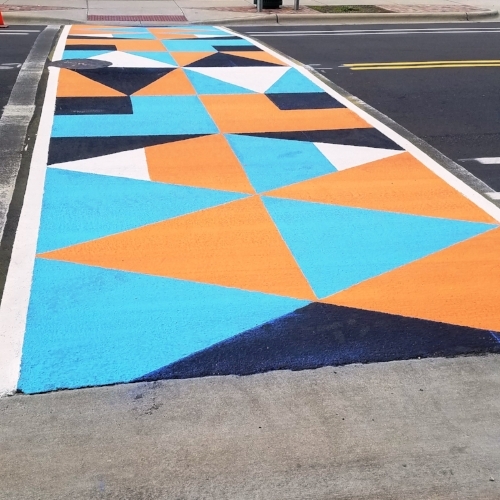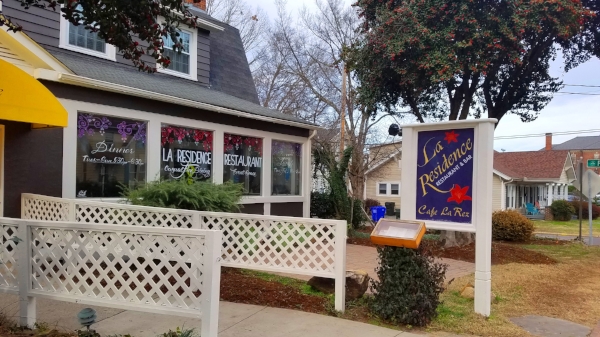Everyone knows Franklin Street. It’s Chapel Hill’s main drag, the classic college town’s classic strip. But just a block away, parallel to Franklin, is a lesser-known thoroughfare, a street with a wide array of attractions and a multitude of personalities that reflect the variety and always-evolving nature of the community.
In just a mile and a third, Rosemary Street goes from bucolic to commercial, from stately residential to downhome funky. Let’s take a stroll down it.
Starting from the far eastern end, the back of the Horace Williams House and its expansive green lawn reign over the Franklin-Rosemary Historic District. Built in the 1850s and the only historic home open to the public in Chapel Hill, the Williams House now provides meeting and event space, offers art exhibitions, public education programs, classical concerts and holiday strolls.

At this end of the street, supposedly, lived a young woman named Rose. At the other end lived a young woman named Mary. Or perhaps it was the other way around. In any case, according to the local story, that’s how the street got its name.
This is an entirely residential area of massive live oaks and grand, gracious homes, many in Greek Revival style, with impressive wrap-around porches. Walking this part of Rosemary, it feels like you’re not just in another place, but in another time, a more sedate period. The only sound here is the crunch of footsteps on the sandy gravel that serves as a sidewalk. The buzz of traffic from that main drag, just a few yards away, is dim.
As you head west, nearing the UNC campus, some of these large homes are now fraternity or sorority houses. At the Alpha Delta Pi house, under ferns hanging from the impressive porch, a solitary student stares intently into a laptop on her, yes, lap.
At the northwest corner of Hillsborough Street, at 315 East, is the elegant Federal-style home that has become known as the Betty Smith House, where the author of “A Tree Grows in Brooklyn” lived for a number of years.
Continuing westward, there’s a mini playground here on the left. It’s part of the daycare operation of one of the many churches in the area, University Presbyterian. This is where parents drop off their kids as they head to nearby jobs at the university.
As you approach Henderson Street, suddenly the sidewalks become wider and smoother, the street opening up. The new sidewalks here and to the west are part of Chapel Hill’s Street Improvement Program, designed to make Rosemary more pleasant and walkable. The brightly colored crosswalks at Henderson are also part of the project.

We’re entering the commercial part of Rosemary now. On our right are student bars and the offices of UNC Chapel Hill’s student newspaper, The Daily Tar Heel, with its big metal globe outside. From Henderson to Columbia Street, there’s parking space everywhere. At the Wallace Deck, you can park your car and then go up to the rooftop terrace to eat a picnic lunch or just watch the world go by —slowly on Rosemary Street, more quickly on Franklin.
When you cross Columbia Street, the biggest intersection, watch the student bicyclists pedaling strenuously to get up the hill and get to campus. In fact, this is the hill that gave Chapel Hill its name.
At the corner of the intersection stands the dark brick old Chapel Hill Town Hall, which had been, for a couple of decades, the Inter-Faith Council for Social Service men’s shelter and community kitchen. It’s still the kitchen, but for not much longer and the town is considering the possible future use of the facility as both a visitors and history center.
You’re now officially on West Rosemary, and the old Northside neighborhood is, in fact, just to your north. The modest houses with their tidy lawns for generations had been the center of the local working-class African-American community. Now it’s become more and more filled with students, but designation as a historic district has tried to stem that change.
Old meets new towards Church Street as La Residence, Chapel Hill’s first gourmet French restaurant — celebrating 40 years, says the sign in front — sits right next to a new four-story AC Marriott, Chapel Hill's newest hotel.

Past Church Street is the newest part of Rosemary, with residential towers, mostly for students, like the Shortbread Lofts and The Warehouse. The buildings are part of the town’s efforts to increase the amount of commercial and residential space downtown.
And there is perhaps more to come. The town is considering a plan to construct, from Andrew Lane to Nunn Lane, a mixed-use development of retail, office space and residential apartments, on the site of what’s now Breadman’s restaurant.
In the meantime, though, you can eat breakfast, which is served all day, in complete safety at Breadman’s, where it always seems that many tables are occupied by police officers or fire fighters, taking their meal breaks from their nearby station houses.
By Mitchell Lane, the street turns trendier and more ethnic. Here there are brightly painted restaurants and bars, like the Northside District, where you can get free fries with every pitcher, sitting next to La Nueva Guadalupana, a Hispanic grocery where you can send money or buy meat.
Catty-corner across Rosemary is Mama Dip’s, Chapel Hill’s bastion of soul food, originally started by Mama Dip (Mildred Council) and the tradition now carried on by her family.

The small storefronts are now interrupted by the bulk of the Greenbridge condo tower, which caused a significant amount of controversy when it was built a decade ago. Was it too big for the neighborhood? Too expensive? Out of scale? Now its futuristic look is a familiar site.
In its shadow is the easily overlooked Bread & Butter café, off Roberson Street, where you really should pick up one of the honey-glazed brioche cinnamon rolls.
The last block or so of Rosemary, before it becomes East Main Street, is remarkably eclectic. There’s a tattoo parlor and Bowbarr, a hipster “Carrboro drinkery.” There’s an old barber shop and a vape store, as well as the almost-hidden courtyard entrance to Carrburritos (try the salsa verde). as well as a Buddhist Center and a modern furniture and accessories store.
It’s a testament to the incredible diversity of one of the area’s most interesting streets.


